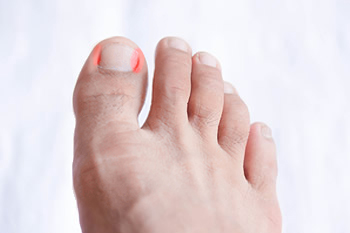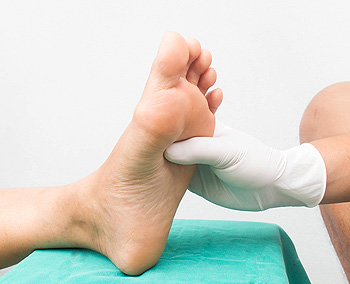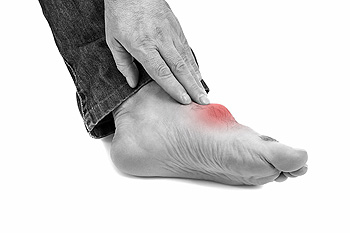
 An ingrown toenail occurs when a curved toenail grows into the skin on the sides of the nail. The toenail digs into the skin and causes pain, redness, and swelling as the skin grows around the nail. If left untreated, it can cause a bacterial infection. Ingrown toenails are often caused by trauma, tightly fitting shoes, or cutting the toenails at an angle instead of straight across. Those who notice an ingrown toenail should treat it immediately by soaking it in warm water, drying it with a towel, and bandaging it. If there is significant swelling, pain, inflammation or discharge, the toenail is likely infected. Ingrown toenails that won’t heal, occur frequently, or are infected should be looked at by a podiatrist.
An ingrown toenail occurs when a curved toenail grows into the skin on the sides of the nail. The toenail digs into the skin and causes pain, redness, and swelling as the skin grows around the nail. If left untreated, it can cause a bacterial infection. Ingrown toenails are often caused by trauma, tightly fitting shoes, or cutting the toenails at an angle instead of straight across. Those who notice an ingrown toenail should treat it immediately by soaking it in warm water, drying it with a towel, and bandaging it. If there is significant swelling, pain, inflammation or discharge, the toenail is likely infected. Ingrown toenails that won’t heal, occur frequently, or are infected should be looked at by a podiatrist.
Ingrown toenails can become painful if they are not treated properly. For more information about ingrown toenails, contact one of our podiatrists of Achilles Foot Clinic. Our doctors can provide the care you need to keep you pain-free and on your feet.
Ingrown Toenails
Ingrown toenails occur when a toenail grows sideways into the bed of the nail, causing pain, swelling, and possibly infection.
Causes
Prevention
Because ingrown toenails are not something found outside of shoe-wearing cultures, going barefoot as often as possible will decrease the likeliness of developing ingrown toenails. Wearing proper fitting shoes and using proper cutting techniques will also help decrease your risk of developing ingrown toenails.
Treatment
Ingrown toenails are a very treatable foot condition. In minor cases, soaking the affected area in salt or antibacterial soaps will not only help with the ingrown nail itself, but also help prevent any infections from occurring. In more severe cases, surgery is an option. In either case, speaking to your podiatrist about this condition will help you get a better understanding of specific treatment options that are right for you.
If you have any questions, please feel free to contact one our office, located in the South of Calgary, Alberta. We offer the newest diagnostic and treatment technologies for all your foot care needs.
 Implementing methods that can help to prevent running injuries is crucial to thoroughly enjoying the sport of running or jogging. Good habits can consist of warming up and cooling down before and after running, and it is beneficial to wear shoes that fit correctly. Additionally, it helps to gradually increase speed and mileage, as this can build endurance over time. Professional runners state it is best to increase the miles that are run by 10 percent or less per week. If you would like more information about foot conditions that can occur from running, running injuries, and how to prevent them, please consult with a podiatrist.
Implementing methods that can help to prevent running injuries is crucial to thoroughly enjoying the sport of running or jogging. Good habits can consist of warming up and cooling down before and after running, and it is beneficial to wear shoes that fit correctly. Additionally, it helps to gradually increase speed and mileage, as this can build endurance over time. Professional runners state it is best to increase the miles that are run by 10 percent or less per week. If you would like more information about foot conditions that can occur from running, running injuries, and how to prevent them, please consult with a podiatrist.
All runners should take extra precaution when trying to avoid injury. If you have any concerns about your feet, contact one of our podiatrists of Achilles Foot Clinic. Our doctors will treat your foot and ankle needs.
How to Prevent Running Injuries
There are a lot of mistakes a runner can make prior to a workout that can induce injury. A lot of athletes tend to overstretch before running, instead of saving those workouts for a post-run routine. Deep lunges and hand-to-toe hamstring pulls should be performed after a workout instead of during a warmup. Another common mistake is jumping into an intense routine before your body is physically prepared for it. You should try to ease your way into long-distance running instead of forcing yourself to rush into it.
More Tips for Preventing Injury
If you have any questions, please feel free to contact one our office, located in the South of Calgary, Alberta. We offer the newest diagnostic and treatment technologies for all your foot care needs.
 There are many reasons people can develop diabetes. These can consist of genetics, environmental factors, and eating habits. The feet are often affected in diabetic patients, and it may be difficult to feel sensations. This can result in the development of foot ulcers, and in severe cases, the toes and entire foot can be lost to amputation. It is beneficial to check your feet on a daily basis for any cuts, scrapes, or sores. It is important to wear shoes that fit correctly, and this can be implemented by trying shoes on at the end of the day when the feet are generally at their largest. There are several methods diabetic patients can use to protect their feet, and it is suggested that a podiatrist be consulted for additional information.
There are many reasons people can develop diabetes. These can consist of genetics, environmental factors, and eating habits. The feet are often affected in diabetic patients, and it may be difficult to feel sensations. This can result in the development of foot ulcers, and in severe cases, the toes and entire foot can be lost to amputation. It is beneficial to check your feet on a daily basis for any cuts, scrapes, or sores. It is important to wear shoes that fit correctly, and this can be implemented by trying shoes on at the end of the day when the feet are generally at their largest. There are several methods diabetic patients can use to protect their feet, and it is suggested that a podiatrist be consulted for additional information.
Diabetic foot care is important in preventing foot ailments such as ulcers. If you are suffering from diabetes or have any other concerns about your feet, contact one of our podiatrists from Achilles Foot Clinic. Our doctors can provide the care you need to keep you pain-free and on your feet.
Diabetic Foot Care
Diabetes affects millions of people every year. The condition can damage blood vessels in many parts of the body, especially the feet. Because of this, taking care of your feet is essential if you have diabetes, and having a podiatrist help monitor your foot health is highly recommended.
The Importance of Caring for Your Feet
Patients with diabetes should have their doctor monitor their blood levels, as blood sugar levels play such a huge role in diabetic care. Monitoring these levels on a regular basis is highly advised.
It is always best to inform your healthcare professional of any concerns you may have regarding your feet, especially for diabetic patients. Early treatment and routine foot examinations are keys to maintaining proper health, especially because severe complications can arise if proper treatment is not applied.
If you have any questions, please feel free to contact one our office, located in the South of Calgary, Alberta. We offer the newest diagnostic and treatment technologies for all your foot care needs.
 Gout is a very painful type of arthritis that can cause joints to become stiff, hot, or tender. Gout is caused by a buildup of uric acid, most commonly affected is the big toe. Those who eat a lot of foods that contain high purine levels, such as red meat, seafood, and alcohol, are at an increased risk for developing gout. Other risk factors that may contribute to the onset of gout can include include genetics, family history, sex, or age. Gout is found to be more common in men and the risk increases with age. Because there is no cure for gout, even when no symptoms are present, it is important to manage this condition correctly. One key to managing gout is keeping a healthy weight because excess body weight can lead to more uric acid in the body. Another key to managing gout is to have a well balanced diet that cuts down on the intake of foods and alcohols that are rich in purines. Staying hydrated is important as well. If you are afflicted with gout, make sure to check with a podiatrist for help managing it as well as various treatment techniques.
Gout is a very painful type of arthritis that can cause joints to become stiff, hot, or tender. Gout is caused by a buildup of uric acid, most commonly affected is the big toe. Those who eat a lot of foods that contain high purine levels, such as red meat, seafood, and alcohol, are at an increased risk for developing gout. Other risk factors that may contribute to the onset of gout can include include genetics, family history, sex, or age. Gout is found to be more common in men and the risk increases with age. Because there is no cure for gout, even when no symptoms are present, it is important to manage this condition correctly. One key to managing gout is keeping a healthy weight because excess body weight can lead to more uric acid in the body. Another key to managing gout is to have a well balanced diet that cuts down on the intake of foods and alcohols that are rich in purines. Staying hydrated is important as well. If you are afflicted with gout, make sure to check with a podiatrist for help managing it as well as various treatment techniques.
Gout is a foot condition that requires certain treatment and care. If you are seeking treatment, contact one of our podiatrists from Achilles Foot Clinic. Our doctors will treat your foot and ankle needs.
What Is Gout?
Gout is a type of arthritis caused by a buildup of uric acid in the bloodstream. It often develops in the foot, especially the big toe area, although it can manifest in other parts of the body as well. Gout can make walking and standing very painful and is especially common in diabetics and the obese.
People typically get gout because of a poor diet. Genetic predisposition is also a factor. The children of parents who have had gout frequently have a chance of developing it themselves.
Gout can easily be identified by redness and inflammation of the big toe and the surrounding areas of the foot. Other symptoms include extreme fatigue, joint pain, and running high fevers. Sometimes corticosteroid drugs can be prescribed to treat gout, but the best way to combat this disease is to get more exercise and eat a better diet.
If you have any questions, please feel free to contact one our office, located in the South of Calgary, Alberta. We offer the newest diagnostic and treatment technologies for all your foot care needs.